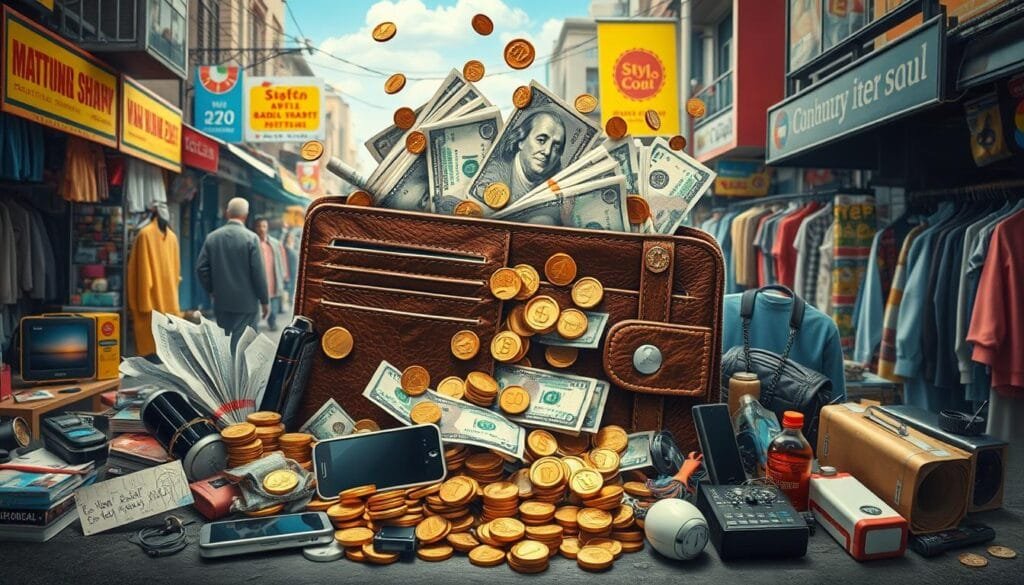Have you ever thought about why some have lots of stuff while others have little? Economic principles help us understand the reasons behind this. These principles reveal surprising insights into material wealth.
We are going to look at why people gather different amounts of stuff. We’ll see how spending habits and managing personal assets explain this phenomenon. Concepts from both microeconomics and macroeconomics help us understand the impact of income, economic cycles, and preferences.
Economics studies how we use limited resources and make decisions. It explains why some have full closets and others choose simplicity. We’ll discuss how demand elasticity and marketing influence our shopping habits. This will show us why we collect so many things.
For a deeper understanding, organizations like the American Economic Association offer great resources. At its core, economics is about the choices we make. These choices determine the amount and kind of stuff we accumulate.
Key Takeaways
- Material wealth can be analyzed through the lens of economic principles.
- Microeconomics focuses on individual decisions, influencing personal assets and consumer spending.
- Behavioral economics provides insights into the irrational aspects of economic behavior.
- Income levels and marketing play critical roles in determining the amount and types of possessions.
- Resources like the American Economic Association offer extensive economic research.
Introduction to Economics and Material Wealth
Economics teaches us how people use resources to fulfill their wants and needs. It’s about how we manage limited resources to achieve various ends. This concept is key in understanding how material wealth is amassed. It also sheds light on why wealth disparities exist in different economic systems.
Decision-making is crucial in our lives. About 90% of our decisions are about how to use resources. These choices affect all areas of our lives, including what we buy and save. Through economics, we see how our choices connect us to the world via resource use.
“Economics is the study of mankind in the ordinary business of life,” observed Alfred Marshall. This highlights how economics applies to our daily interactions.
Economic theories link economic growth to our well-being. Almost 80% of economists claim this growth makes us happier. It shows that getting wealthier is not just about more money. It also means a better lifestyle and access to more resources.
Wealth disparities emerge from uneven resource distribution. For instance, in 2022, the richest 1% in the U.S. earned 27% of all income. This indicates a huge income gap. Also, economics has political aspects, as seen in historical critiques like Carlyle’s “dismal science.” Around 68% of economists believe that politics heavily influences economic issues. This makes the study of economics complex and intertwined with how societies are governed.
| Aspect | Influence |
|---|---|
| Income Distribution | 27% captured by the top 1% |
| Productivity Increase | Up to 50% through labor specialization |
| Economic Agreement | 75% consensus on core economic principles |
| Public Belief in Disagreements | 45% think economists disagree fundamentally |
Factors Influencing Material Accumulation
The link between consumer income and buying power is clear when we look at economic growth. This is measured by the gross domestic product (GDP). For example, the U.S. GDP jumped from $2.0 trillion in 1950 to $9.9 trillion in 2000. This big leap boosted how much people spend. As people earn more, they buy more normal goods like food, clothes, and electronics.

Income Levels and Normal Goods
What people earn greatly impacts what they decide to buy. With more money, they can buy more goods and services. The U.S. saw its population grow from 152 million in 1950 to over 281 million in 2000. This growth, combined with higher incomes, pushed up the demand for normal goods. The higher the disposable income, the more people tend to buy.
Behavioral Economics and Consumer Behavior
Behavioral economics looks at how people spend money, which can differ from what experts predict. It examines how mindsets and social norms influence spending. For example, the rise in urban living, with almost half the world’s people in cities, drives up the need for more goods. This increase in demand, fueled by both money and behavior, requires us to thoroughly understand how materials flow.
The complex link between how much stuff people collect and economic factors can be seen by looking at the factors of production. Behavioral economics shows us that what people actually do can stray from what we expect due to psychological and social factors.
The way income, buying power, and spending behavior interact is key in behavioral economics. Studying these gives us insight into the complex forces that shape how goods pile up and spread in a changing economy.
Role of Microeconomics in Understanding Individual Inventory
Microeconomics helps us understand why people buy, keep, or get rid of things. It looks into consumer choices deeply. A big idea here is consumer theory. It links happiness with how much we consume, suggesting more consumption brings more joy.

Consumer preferences are shown through utility functions. These are tied to how much money we have to spend, which limits what we can buy. Understanding this link helps us see why we buy less of something when it gets more expensive. For example, if cars cost more, people tend to buy fewer cars. This shows how sensitive prices are to changes.
Market structures, like monopolies or competitive markets, change how economic models work. Companies try to make as much profit as possible by adjusting their production based on costs and technology. A big event, like a major copper mine collapsing, can make prices jump by reducing supply.
Behavioral economics adds depth to microeconomics. It mixes in psychological, social, and cognitive aspects. It often uses complex math to explore how we make choices.
Looking at labor economics gives us more insight into microeconomics. It studies how workers and companies interact, looking at wages, jobs, and how income is spread out. For example, if the minimum wage goes up, The Wendy’s Company might hire differently, showing how the job market can change.
Microeconomics also looks at the stock market. An example is how Apple’s stock prices fell when iPhone sales went down. This field shows us how personal choices impact the economy, especially how supply and demand determine prices and balance in the economy.
| Concept | Description | Example |
|---|---|---|
| Consumer Theory | Examines the relationship between utility and consumption, indicating higher consumption leads to increased happiness. | Higher car prices generally lead to fewer cars purchased. |
| Utility Functions | Models consumer preferences and connects to the budget constraint. | Utility maximization given a limited budget. |
| Market Structures | Different strategies required for monopolies versus competitive markets. | Price increase of copper due to a major mine collapse. |
| Labor Economics | Examines interactions between workers and firms, studying wage patterns and employment rates. | Impact of higher minimum wage on The Wendy’s Company’s hiring. |
| Behavioral Economics | Incorporates psychological, social, and cognitive aspects into economic analysis. | Decision-making under uncertainty. |
To sum up, understanding individual decisions about what to buy or not is crucial. Microeconomics gives us tools to understand these choices in different economic settings. It opens up a clearer view of how personal decisions reflect in the wider economy.
how much stuff a person has economics trems
To understand how much stuff someone has, we look at special economic terms. One important term is income elasticity of demand. It shows how wanting different goods changes with income changes. This concept helps us know how goods are divided into three types.
Income Elasticity of Demand
This concept is key in figuring out consumption patterns. It shows us how the want for goods changes with income changes. When income elasticity is high, people’s desire for goods changes a lot with income shifts. Financial markets, moving trillions daily, show how these income changes affect both producers and consumers.

Think about when a country’s GDP goes up. Like how the UK checks it monthly and quarterly. This means people have more money to spend. So, they buy more normal, inferior, and luxury goods. By looking at elasticity of demand, we understand how markets and buying habits change.
Distinction Between Normal, Inferior, and Luxury Goods
Sorting goods into normal, inferior, and luxury groups tells us a lot about economic behavior. When people earn more, how they buy changes. This affects the demand for these goods types:
| Goods Type | Characteristics | Example |
|---|---|---|
| Normal Goods | Demand increases with higher income | Quality clothing, preferred groceries |
| Inferior Goods | Demand decreases as income rises | Instant noodles, second-hand items |
| Luxury Goods | Significant demand increase with higher income | High-end cars, designer apparel |
Knowing these differences teaches us about what people value. For instance, when the economy grows, shown by GDP or GNP increases, it usually means people buy more normal or luxury goods and less inferior goods. So, understanding demand elasticity helps forecast economic behaviors, through good and bad times.
Conclusion
In our journey through economics, we’ve looked at many things that change how much stuff people own. This includes everything from how much money they make to their buying habits. Knowing about wealth through economics helps us understand how decisions impact both individuals and society.
Economists like John Stuart Mill and Milton Friedman have shown us the importance of looking at facts. Their work reveals how careful analysis can transform our understanding of economies. For example, studies in Seattle saw fewer unemployed people after the minimum wage rose to $15. Yet, other research showed lower earnings for those with low income. This highlights the complexities in our economies.
We’ve learned a lot from the past and present economic situations, from the Soviet Union’s issues to the US’s changing interest rates. This knowledge of how people get and use their possessions gets deeper over time. It sheds light on how economic understanding and policy changes are crucial. They not just help us grasp the concept of wealth but also equip us for making smarter decisions in the economic challenges ahead.
FAQ
How do income levels influence material wealth accumulation?
When people earn more, they buy more things like food and clothes. They can afford more, leading to more personal assets. This means they gather more wealth.
What role does behavioral economics play in consumer spending habits?
Behavioral economics looks at how people’s behavior affects what they buy. It mixes psychology with economics. This helps understand why people buy differently than expected.
How does microeconomics help us understand individual inventory decisions?
Microeconomics studies how people decide what to buy, keep, or throw away. It looks at choices, limits, and market effects. This tells us about personal material choices.
What is the income elasticity of demand?
Income elasticity shows how demand changes with income shifts. It sorts goods into normal, inferior, and luxury. This shows what goods people buy more as they earn more.
What distinguishes normal goods from inferior and luxury goods?
Normal goods are more in demand as incomes rise. Inferior goods are less wanted, while luxury items see a big jump in demand. This shows how wealth affects choices.
Can economic principles predict future consumer behavior?
Economic principles analyze behaviors and trends to guess future actions. They can’t be sure, but they help us guess and make decisions.
